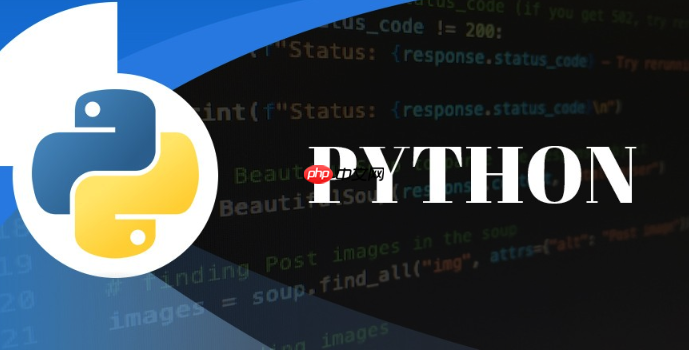答案:FastAPI通过@app.exception_handler注册全局异常处理器,统一捕获HTTPException、RequestValidationError、自定义异常及未处理异常,实现一致的错误响应格式,提升可维护性与安全性。

FastAPI处理全局异常的核心思路,在于通过注册自定义的异常处理器来统一管理和响应各种运行时错误。这不仅能让你的API接口在面对问题时表现得更加健壮和一致,还能极大地提升开发和维护的效率,避免了在每个视图函数中重复编写错误处理逻辑。说实话,没有一个完善的全局异常捕获机制,任何稍微复杂点的项目都会变得难以维护。
在FastAPI中,你可以使用
@app.exception_handler
1. 捕获FastAPI/Starlette内置的HTTP异常
FastAPI底层基于Starlette,因此它能很好地处理
HTTPException
HTTPException
from fastapi import FastAPI, HTTPException, Request, status
from fastapi.responses import JSONResponse
app = FastAPI()
# 示例:一个会抛出HTTPException的路由
@app.get("/items/{item_id}")
async def read_item(item_id: int):
if item_id == 0:
raise HTTPException(status_code=status.HTTP_404_NOT_FOUND, detail="Item not found")
return {"item_id": item_id}
# 注册一个全局的HTTPException处理器
@app.exception_handler(HTTPException)
async def http_exception_handler(request: Request, exc: HTTPException):
# 这里可以做日志记录,或者根据exc.status_code做更细致的判断
print(f"HTTPException caught: {exc.detail}, status: {exc.status_code}")
return JSONResponse(
status_code=exc.status_code,
content={"message": exc.detail},
)2. 捕获FastAPI的请求验证异常 (RequestValidationError
当请求数据不符合Pydantic模型定义时(例如,请求体字段缺失、类型错误),FastAPI会自动抛出
RequestValidationError
from fastapi.exceptions import RequestValidationError
from pydantic import BaseModel
class Item(BaseModel):
name: str
price: float
@app.post("/items/")
async def create_item(item: Item):
return item
# 注册一个RequestValidationError处理器
@app.exception_handler(RequestValidationError)
async def validation_exception_handler(request: Request, exc: RequestValidationError):
# exc.errors()会返回详细的验证错误列表
# print(f"Validation error caught: {exc.errors()}")
# 我们可以选择性地只返回第一个错误或者格式化所有错误
error_details = [{"loc": err["loc"], "msg": err["msg"], "type": err["type"]} for err in exc.errors()]
return JSONResponse(
status_code=status.HTTP_422_UNPROCESSABLE_ENTITY,
content={"message": "Validation error", "details": error_details},
)3. 捕获自定义异常
对于业务逻辑中特有的错误,我们可以定义自己的异常类,并在处理器中捕获它们。
class MyCustomException(Exception):
def __init__(self, name: str, message: str = "A custom error occurred"):
self.name = name
self.message = message
@app.get("/custom_error")
async def trigger_custom_error():
raise MyCustomException(name="CustomErrorType", message="Something went wrong in custom logic!")
# 注册自定义异常处理器
@app.exception_handler(MyCustomException)
async def custom_exception_handler(request: Request, exc: MyCustomException):
print(f"Custom exception caught: {exc.name} - {exc.message}")
return JSONResponse(
status_code=status.HTTP_400_BAD_REQUEST, # 或者其他合适的HTTP状态码
content={"code": exc.name, "message": exc.message},
)4. 捕获所有未被处理的异常(兜底)
为了确保没有任何异常被遗漏,你可以注册一个针对
Exception
import traceback
@app.exception_handler(Exception)
async def universal_exception_handler(request: Request, exc: Exception):
# 记录详细的错误信息,包括堆栈跟踪,这对于调试至关重要
print(f"An unexpected error occurred: {type(exc).__name__}: {exc}")
print(traceback.format_exc()) # 打印完整的堆栈信息
return JSONResponse(
status_code=status.HTTP_500_INTERNAL_SERVER_ERROR,
content={"message": "An unexpected server error occurred. Please try again later."},
)通过以上这些处理器,你的FastAPI应用就能建立起一套全面且统一的异常处理机制。
在我看来,全局异常捕获在大型项目中的作用,远不止是让代码看起来更整洁那么简单。它更像是一道防线,一道保证系统稳定性和用户体验的防线。试想一下,如果每个API端点都要自己去处理各种可能出现的错误,比如数据库连接失败、外部服务超时、用户输入格式错误等等,那代码里会充斥着大量的
try...except
首先,它确保了API响应的一致性。无论内部发生了什么错误,用户总是能收到一个结构化、可预期的错误响应,而不是一个空白页或者一个晦涩难懂的服务器错误。这种一致性对于前端开发人员来说尤其重要,他们可以基于固定的错误格式来构建用户界面,而不需要为每种错误编写不同的解析逻辑。
其次,它极大地提升了开发效率和可维护性。当新的错误类型出现或者错误响应格式需要调整时,你只需要修改一处全局处理器,而不是遍历成百上千个API端点。这在大型团队协作中,简直是救命稻草。我个人经历过没有全局异常处理的项目,每次调试一个线上问题,都得花大量时间去定位哪个地方的
try...except
再者,它有助于安全性和信息泄露的防护。不加处理的异常往往会泄露服务器内部的敏感信息,比如文件路径、数据库查询语句、堆栈跟踪等。通过全局异常处理器,我们可以精确控制返回给用户的错误信息,只提供必要的、友好的提示,而将详细的调试信息记录在服务器日志中,确保内部细节不会暴露给外部攻击者。
最后,它简化了错误日志记录。所有的异常都可以集中在一个地方进行记录,方便我们统一接入日志系统,进行错误分析、告警和监控。这对于快速发现和解决生产环境中的问题至关重要。
区分处理FastAPI的验证错误和业务逻辑异常,是构建健壮API的关键一步。它们虽然都是错误,但产生的原因、处理方式以及返回给用户的状态码和信息都应该有所不同。我通常会这样来思考和实践:
1. 请求验证错误 (RequestValidationError
这类错误通常发生在FastAPI接收到请求,但请求数据不符合Pydantic模型定义的时候。比如,你期望一个整数,结果用户传了个字符串;或者某个必填字段根本没传。
422 Unprocessable Entity
@app.exception_handler(RequestValidationError)
exc.errors()
loc
msg
type
代码示例(重申并强调):
from fastapi.exceptions import RequestValidationError
from fastapi.responses import JSONResponse
from fastapi import status
# ... (假设app实例和Item模型已定义) ...
@app.exception_handler(RequestValidationError)
async def validation_exception_handler(request: Request, exc: RequestValidationError):
# 格式化错误信息,让客户端更容易理解
formatted_errors = []
for error in exc.errors():
# loc通常是元组,如('body', 'name')
field_name = ".".join(map(str, error["loc"])) if error["loc"] else "unknown"
formatted_errors.append({
"field": field_name,
"message": error["msg"],
"type": error["type"]
})
return JSONResponse(
status_code=status.HTTP_422_UNPROCESSABLE_ENTITY,
content={
"code": "VALIDATION_ERROR",
"message": "Request validation failed.",
"errors": formatted_errors
},
)2. 业务逻辑异常 (自定义异常或 HTTPException
这类错误发生在业务逻辑执行过程中。例如,用户尝试访问一个不存在的资源,或者执行一个没有权限的操作,又或者某个外部服务调用失败。
4xx
400 Bad Request
404 Not Found
403 Forbidden
5xx
500 Internal Server Error
503 Service Unavailable
UserNotFoundException
PermissionDeniedException
HTTPException
HTTPException
代码示例:
# 自定义业务异常
class UserNotFoundException(Exception):
def __init__(self, user_id: int):
self.user_id = user_id
self.message = f"User with ID {user_id} not found."
class InsufficientPermissionsException(HTTPException): # 也可以继承HTTPException
def __init__(self, required_role: str):
super().__init__(status_code=status.HTTP_403_FORBIDDEN, detail=f"Requires role: {required_role}")
self.required_role = required_role
@app.get("/users/{user_id}")
async def get_user(user_id: int):
if user_id == 100:
raise UserNotFoundException(user_id=user_id)
# 假设用户1是管理员
if user_id != 1:
raise InsufficientPermissionsException(required_role="admin")
return {"user_id": user_id, "name": "Admin User"}
# 捕获自定义异常
@app.exception_handler(UserNotFoundException)
async def user_not_found_handler(request: Request, exc: UserNotFoundException):
return JSONResponse(
status_code=status.HTTP_404_NOT_FOUND,
content={"code": "USER_NOT_FOUND", "message": exc.message},
)
# HTTPException会由之前注册的http_exception_handler处理,但你也可以为特定HTTPException子类创建更具体的处理器。
# 例如,如果你想为403 Forbidden返回一个更定制化的响应
@app.exception_handler(InsufficientPermissionsException)
async def permission_denied_handler(request: Request, exc: InsufficientPermissionsException):
return JSONResponse(
status_code=exc.status_code,
content={"code": "PERMISSION_DENIED", "message": exc.detail, "required_role": exc.required_role},
)总结一下,我的做法是:对于数据格式和API契约问题,交给
RequestValidationError
HTTPException
在异常处理中,日志记录和返回友好的错误信息是两个同样重要但目的不同的环节。日志记录是为了方便开发者调试和监控,需要尽可能详细;而返回给用户的错误信息是为了提供清晰的指引,需要简洁、安全且易于理解。这两者之间需要一个巧妙的平衡,不能混为一谈。
1. 详细的日志记录(给开发者看)
当异常发生时,尤其是在兜底的
Exception
type(exc).__name__
str(exc)
request.url
request.method
traceback.format_exc()
我通常会配置Python的
logging
ERROR
import logging
import traceback
from fastapi.responses import JSONResponse
from fastapi import status, Request
# 配置日志(这通常在应用启动时完成)
logging.basicConfig(level=logging.INFO,
format='%(asctime)s - %(name)s - %(levelname)s - %(message)s')
logger = logging.getLogger(__name__)
# ... (假设app实例已定义) ...
@app.exception_handler(Exception)
async def universal_exception_handler(request: Request, exc: Exception):
error_id = "ERR-" + str(uuid.uuid4())[:8] # 生成一个唯一的错误ID,方便追踪
# 记录详细的错误日志
logger.error(
f"[{error_id}] Unhandled Exception at {request.url} ({request.method}): {type(exc).__name__} - {exc}",
exc_info=True, # 自动包含堆栈信息
extra={"request_url": str(request.url), "request_method": request.method}
)
# 返回给用户友好的错误信息
return JSONResponse(
status_code=status.HTTP_500_INTERNAL_SERVER_ERROR,
content={
"code": "INTERNAL_SERVER_ERROR",
"message": "An unexpected error occurred. Please try again later.",
"error_id": error_id # 把错误ID返回给用户,方便他们向客服反馈时提供
},
)2. 友好的错误信息(给用户看)
返回给用户的错误信息需要遵循几个原则:
code
message
details
error_id
4xx
5xx
示例(基于上述日志记录的universal_exception_handler
可以看到,我们返回给用户的
content
code
message
error_id
error_id
对于更具体的异常,比如验证错误或自定义业务异常,返回的信息可以更具体,但仍然要保持友好和无害:
# ... (假设UserNotFoundException处理器已定义) ...
@app.exception_handler(UserNotFoundException)
async def user_not_found_handler(request: Request, exc: UserNotFoundException):
logger.warning(f"User not found for ID: {exc.user_id} at {request.url}") # 记录为警告,因为这不是服务器崩溃
return JSONResponse(
status_code=status.HTTP_404_NOT_FOUND,
content={
"code": "USER_NOT_FOUND",
"message": exc.message # 这里的message已经是业务友好的
},
)通过这种分层处理,我们既满足了开发者对详细调试信息的需求,又确保了用户能收到清晰、安全、友好的错误反馈,这对于任何一个严肃的API项目来说都是不可或缺的。
以上就是FastAPI 的全局异常捕获方法的详细内容,更多请关注php中文网其它相关文章!

每个人都需要一台速度更快、更稳定的 PC。随着时间的推移,垃圾文件、旧注册表数据和不必要的后台进程会占用资源并降低性能。幸运的是,许多工具可以让 Windows 保持平稳运行。

Copyright 2014-2025 https://www.php.cn/ All Rights Reserved | php.cn | 湘ICP备2023035733号